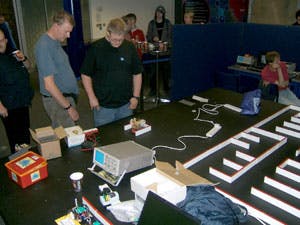News and Events
 The inspiration for Micromouse began in 1972 when mechanical mice were built with springs for a racing contest, sponsored by the Machine Design magazine.
The inspiration for Micromouse began in 1972 when mechanical mice were built with springs for a racing contest, sponsored by the Machine Design magazine.
It wasn’t until 1977 that the idea of the Micromouse as a maze solving device was introduced by the IEE Spectrum Magazine, with Spectrum announcing an Amazing Micromouse Maze Contest would be held in June 1979 in New York.
6,000 entries were received, but only 15 micromice competed. The winner was Moonlight Flash, a dumb wall follower mouse.
In subsequent competitions the rules became more sophisticated, so competitors had a more difficult challenge in building more intelligent mice able to find the centre of the maze.
The 1980s
- 1980: The first European competition takes place in London
Among the 100 entries received only nine mice compete at the finals, with only Sterling – Nick Smith’s mouse – finding the centre of the maze. Delegates from the Japan New Science Foundation take the rules back to Tokyo and organise the first All- Japan Micromouse Contest in November, but none of the mice solved the maze. - 1981: Nick Smith’s Sterling Mouse wins second European competition in Paris
There are 13 competitors but Sterling wins again, being the faster of the eight mice to reach the centre of the maze. In the second Micromouse UK contest held in Wembley Dave Woodfield’s Thumper takes first place. - 1982: Alan Dibley wins the 1982 Micromouse UK competition with his Thezeus mice.
- 1985: The first World Micromouse Competition is held in August in Tsubuka, Japan.
The competition is open to contestants from Europe and the USA. The mice are now becoming quite sophisticated, using infra-red or ultrasonic sensors, stepper or DC servo-motors.
Champion is the Japanese Noriko-1, with the best non-Japanese contestant being Dave Woodfield’s Enterprise in 7th position. - 1987: New scoring is introduced to reward mice able to solve the maze completely independently
10 seconds are deducted to the run time if the mouse is never touched from start to finish. The World Micromouse Competition, hosted by the Institution of Electrical Engineers in London, is contested by 13 competitors. David Otten, from MIT, wins the two first prizes with Mitee Mouse I and II.
The 1990s
- 1990: Micromouse clubs start to appear in schools.
- 1991: The championship rules are changed for the World Championship in Hong-Kong
These are the rules being used today that focus on reliability, not just pure speed. The 1991 Champs is the largest international gathering of mice since Tsukuba in 1985, with 30 mice from 13 countries. - 1992: An IEE micromouse competition in London sees the fastest mouse miss out on first place.
Victory goes to Mitee Mouse III, even though the Canadian Louis Geoffrey’s Mouse Mobile II made the fastest run of the nine mice running. - 1999: the Exeter University competition becomes the last one to be run by the IEE.
2000 to today
- 2000: Royal Holloway organises its first event in London and mice appear on TV for the BBC show Technogames.
- 2001: The first Schools and Colleges competition is hosted by Manchester Metropolitan University.
Since then, every year, a Micromouse event, a MINOS event (conference and competition hosted at Royal Holloway), a School and College competition at MMU and a Technogames filming show the success of Micromouse in the UK. - 2004: For the first time, the national UK Micromouse championship is hosted at the Technology Innovation Centre, in Birmingham.
- 2011: UK Micromouse becomes part of the Birmingham Techfest, a celebration of technology and science.